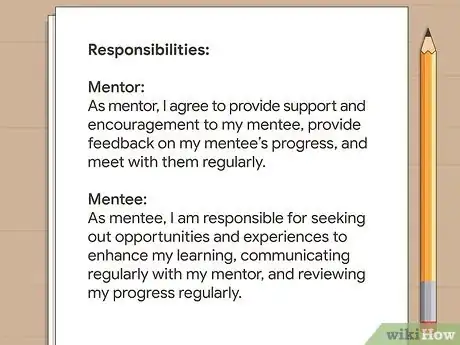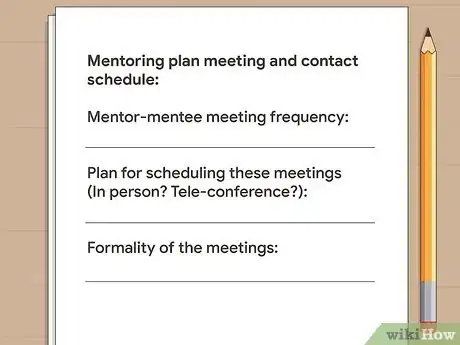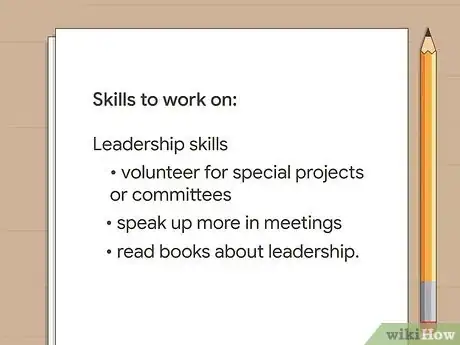This article was co-authored by Archana Ramamoorthy, MS. Archana Ramamoorthy is the Chief Technology Officer, North America at Workday She is a product ninja, security advocate, and on a quest to enable more inclusion in the tech industry. Archana received her BS from SRM University and MS from Duke University and has been working in product management for over 8 years.
wikiHow marks an article as reader-approved once it receives enough positive feedback. In this case, 95% of readers who voted found the article helpful, earning it our reader-approved status.
This article has been viewed 185,778 times.
A mentoring plan is a way to clarify and formalize a relationship between a mentor and mentee. Once you’ve been matched with your mentor or mentee, you can outline the specifics of your roles and define guidelines for the relationship, such as meeting frequency and location. Then, work together to describe goals and objectives. After you’ve established a plan, revisit it twice per year and adjust it as needed to maintain good progress.
Steps
Establishing Roles and Guidelines
-
1Take time to get to know each other before you begin working together. It’s fine to have the first meeting between you and your mentor or mentee be all about getting to know each other and this may even help to forge a positive relationship. Choose to meet at a designated time and place. Then, spend about 30-60 minutes in casual conversation. Ask getting-to-know you questions of each other to establish a rapport.[1]
- For example, ask your mentor or mentee where they’re from, where they went to school, what they like to do in their spare time, and if they have any pets.
Tip: To keep the first meeting more formal, meet in a conference room at your place of work or in an office space, such as in the mentor’s office. For a more laid back first meeting, try going somewhere outside of the workplace, such as to a coffee shop or restaurant for lunch.
-
2Discuss desired outcomes for the relationship. When you first begin working together, plan a conversation to establish the basic goals you’ll be working towards. These can be broad goals that you narrow down later to pinpoint the mentee's more specific professional objectives. Some things the mentor and mentee might list as goals for their relationship include:[2]
- Increasing the speed at which the mentee learns their role and achieves competency
- Fostering leadership development
- Reducing stress and preventing burnout
- Improving the mentee’s motivation and job satisfaction
- Increasing the chances that the mentee will stay with the company long-term[3]
EXPERT TIPArchana Ramamoorthy is the Chief Technology Officer, North America at Workday She is a product ninja, security advocate, and on a quest to enable more inclusion in the tech industry. Archana received her BS from SRM University and MS from Duke University and has been working in product management for over 8 years.Chief Technology Officer, Workday
 Archana Ramamoorthy, MS
Archana Ramamoorthy, MS
Chief Technology Officer, WorkdayExpert Trick: Look for someone who will give you advice from a distance. Mentorship is a way to get an outside perspective on who you are and the skills you are working on, but your mentor doesn't have to get involved in the day to day details.
Advertisement -
3Identify each person’s responsibilities. Once you’ve established some goals, figure out what the relationship will involve by specifying what you and your mentor or mentee will responsible for doing. State these responsibilities clearly so there is no mistaking each person’s role.[4]
- For example, if you are the mentee, you might write something like, “As mentee, I am responsible for seeking out opportunities and experiences to enhance my learning, communicating regularly with my mentor, and reviewing my progress regularly.”
- If you are the mentor, you might write something like, “As mentor, I agree to provide support and encouragement to my mentee, provide feedback on my mentee’s progress, and meet with them regularly.”
-
4Specify how often you and your mentor or mentee will meet. Try to meet with your mentor or mentee 3-4 times over the course of 6 months, or more often if desired. Meeting more often may help to promote good progress, especially in the first 1-2 years of your relationship. Other things to consider when planning your meetings include:[5]
- Where you will meet
- The level of formality of your meetings
- What you’ll cover in your meetings
- When you will meet again
Outlining Goals and Objectives
-
1Write down the mentee’s long-term career goals. Identifying the mentee’s ultimate or major career goal will help you to create clear objectives to work on. If you’re the mentee, discuss your career goals with your mentor and then state your career goal as a main objective of the mentorship plan. If you’re the mentor, discuss the mentee’s career goals with them to help them develop their ideas and then help them to turn this into a definitive statement.[6]
- For example, you might write something like, “My ultimate goal is to become a tenured professor and move into an administrative role, such as dean or vice president.”
-
2Express short-term goals for the next 5-10 years of the mentee’s career. These may include things that the mentee would like to accomplish within the next 1, 2, 3, 5, or even 10 years. List each short-term goal and the proposed timeline for achieving it.[7]
- For example, you might write something like, “Earn a promotion within my first year of employment.”
- Or, you might write something like, “Publish a book based on my research within 5 years.”
-
3Make a list of skills the mentee wants to work on. Have a discussion about what skills are important for the mentee’s success in their chosen field. Then, make a list of these skills and identify ways that the mentee can work on them.[8]
- For example, if the mentee wants to develop their leadership skills, they might do this by volunteering for special projects or committees, speaking up more in meetings, and reading books about leadership.
- If you are the mentor, you may also want to suggest some skills that you think might be beneficial for the mentee’s career goals.
-
4Identify professional development events for the mentee to attend. Include in the plan any workshops, conferences, or other professional development events that may benefit the mentee.[9] Also, indicate when the events are being held and any important deadlines the mentee should know about, such as a submission deadline for a conference paper.[10]
- For example, you might include in the mentorship plan something like, “Submit a proposal for the annual writer’s conference by January 15th.”
Tip: Any events that the mentor is attending may be a good starting point for the mentee as this will give the mentor opportunities to prepare the mentee and introduce them to people at the event.
-
5Plan introductions to contacts that may benefit the mentee. If you are the mentor and are at a meeting or event that your mentee is attending as well, introduce them to other professionals. Expanding the mentee’s professional social circle is an important goal for furthering their professional development and helping them to achieve their goals.[11]
- Try saying something like, “Hello, Dr. Carlson! Have you met George? He’s our newest addition to human resources.”
- The mentor may also benefit from introducing the mentee to people within their professional circle by renewing and strengthening their professional connections.
Ensuring Good Progress
-
1Evaluate the mentee biannually to check on their progress. Regular progress reviews will help to ensure that you’re making good progress, so set a schedule for these checks. If you’re the mentor, evaluate your mentee once every 6 months. If you’re the mentee, suggest an evaluation every 6 months by discussing it with your mentor and including it in your plan. During 6 month reviews, have the mentor and mentee revisit the mentorship plan, goals, and objectives to see what the mentee has accomplished or what they are working towards.[12]
- For example, if the mentee set a goal to publish a paper by the end of the year, then by the first 6 month review there should be some tangible evidence that the mentee is moving towards that goal, such as having a paper accepted by a scholarly journal or at least having submitted a paper to a journal by that point.
- If you’re the mentor, make sure to provide encouragement and feedback on the mentee’s progress. You can do this by making notes on what they have accomplished and putting these notes into the form of a letter.
- If you’re the mentee, identify any goals that you have not made progress towards and ask for guidance from your mentor, especially if you are struggling with any of your objectives.
-
2Make adjustments to the mentorship plan and goals as needed. After reviewing the mentorship plan together, you and your mentor or mentee can make adjustments to the plan as needed, such as changing goal completion dates, modifying goals, or adding new goals.[13] Use the notes that the mentor made during review and any concerns the mentee stated to adjust the plan.[14]
- For example, if the mentee set a goal to attend 3 professional development workshops within the next year, but they have only found 2 suitable ones, then you might adjust the goal and consider it met.
- Or, if the mentee has already accomplished one of their 2 year goals at the 1 year checkup, then you might set a new goal for them to work towards.
-
3Review the plan together and have both parties sign it. Once you and your mentor are happy with the new or revised plan, you can both sign it to make it official. Ensure that you both agree to the goals and other objectives set forth in the plan and make any changes needed before you sign it.[15]
Tip: Make copies of the plan so that you and your mentor or mentee both have one and distribute a copy to anyone else who might want to review it, such as a department head or human resources manager.
Community Q&A
-
QuestionHow do I prepare a mentorship proposal that I need to submit to my school principal?
 Community AnswerFollow the basic guidelines for creating a mentorship plan. However, you may also want to ask your school principal if there are any other specific details they'd like you to include in the plan.
Community AnswerFollow the basic guidelines for creating a mentorship plan. However, you may also want to ask your school principal if there are any other specific details they'd like you to include in the plan.
References
- ↑ https://www.planning.org.au/documents/item/8391
- ↑ https://www.shrm.org/membership/student-resources/pages/mentorprogram.aspx
- ↑ https://www.forbes.com/sites/forbeshumanresourcescouncil/2019/03/18/six-strategies-for-building-a-mentoring-program-that-benefits-people-and-organizations/#2580edb323d0
- ↑ https://www.indeed.com/career-advice/career-development/workplace-mentoring-program
- ↑ https://www.planning.org.au/documents/item/8391
- ↑ https://mhdi.unl.edu/Mentoring%20Plan%20MHDI.pdf
- ↑ https://mhdi.unl.edu/Mentoring%20Plan%20MHDI.pdf
- ↑ https://www.indeed.com/career-advice/career-development/workplace-mentoring-program
- ↑ https://youth.gov/youth-topics/mentoring/considerations-starting-mentoring-program
- ↑ https://mhdi.unl.edu/Mentoring%20Plan%20MHDI.pdf
- ↑ https://www.shrm.org/membership/student-resources/pages/mentorprogram.aspx
- ↑ https://www.shrm.org/membership/student-resources/pages/mentorprogram.aspx
- ↑ https://youth.gov/youth-topics/mentoring/considerations-starting-mentoring-program
- ↑ https://mhdi.unl.edu/Mentoring%20Plan%20MHDI.pdf
- ↑ https://mhdi.unl.edu/Mentoring%20Plan%20MHDI.pdf
About This Article
A mentoring plan can help guide the relationship between a mentor and a mentee. When you first start working together, take time to discuss your basic goals and figure out what each person’s responsibilities will be. For example, if you’re a mentor you might write “I agree to give support and encouragement to my mentee, provide feedback, and meet regularly.” Some other goals that the mentor might help the mentee achieve include learning company roles and achieving competency, improving motivation and job satisfaction, or increasing the chances of staying with the company long-term. Or, if you’re the mentee, you might say “I am responsible for seeking opportunities and experiences that will enhance my learning.” Based on your goals and responsibilities, decide how often you’ll meet, where you’ll meet, and how formal your meetings will be. To learn how to make adjustments to your mentoring plan, keep reading!









































































